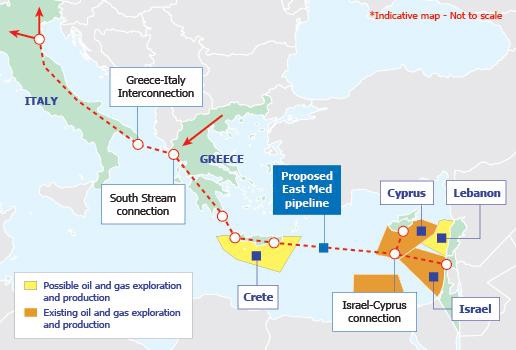21907 - The dynamics of the East Med Pipeline
E. Conophagos, N. Lygeros
Translated from the Greek by Athena Kehagias
When we simply hear about the East Med pipeline, we get the impression that it is regarding just a pipeline amongst many others, whereas in actual fact, as far as we are concerned, it’s certainly amongst the most important ones.
A simple flow chart proves it, but it is interesting to examine it in more detail, taking into account the new data that exist right now.
When the pipeline idea had begun, the Lebanese data were virtually non-existent in the hydrocarbons sector, and in both Egypt and Israel the data weren’t of the present magnitude.
If we examine the schematic map of the company ENI, we can see that Lebanon, Egypt and Israel have links with the nodal EEZ of Cyprus, and the pipeline branches out following the same mental scheme.
Furtheron, it gets connected to the EEZ of Greece, before it reaches the EEZ of Italy in the region Brindisi, with a prospect to supply with energy the European Union in general.
We can see that the pipeline in itself creates an alliance and cooperative context, at a strategic and energean level for a total of six countries, all of which play a role in the Eastern Mediterranean, and this is a guarantee of stability for the region.
In that manner we can also perceive the power that the concept of the EEZ obtains for all these countries, and not solely for us.
We also see that the role of Cyprus is significant, as it has already made three EEZ demarcation agreements and expects to make its fourth with Greece, which has a continental shelf demarcation agreement with Italy since 1977 .
Therefore, in the final phase all these countries will be connected through their EEZ’s but with this pipeline as well.
Additionally with the new data of Egypt, the marketability of the pipeline is no longer theoretical and for this reason we must strengthen it with the tripartite.

